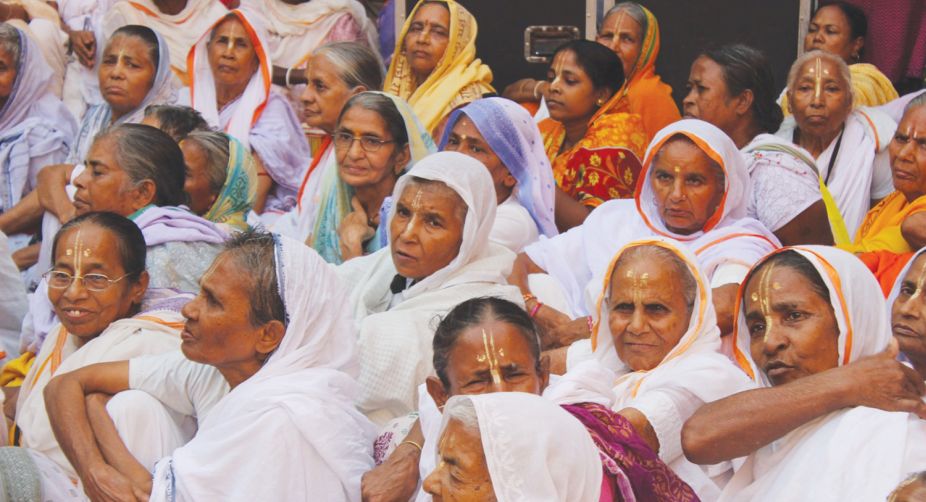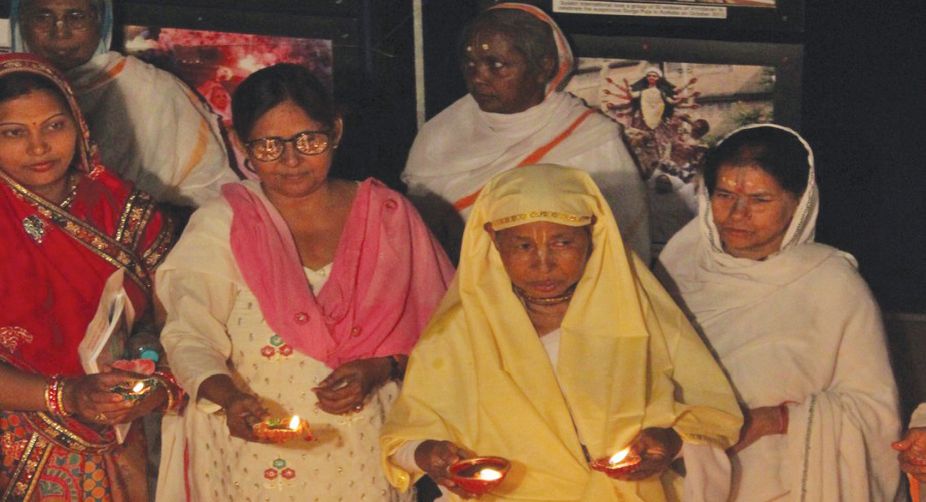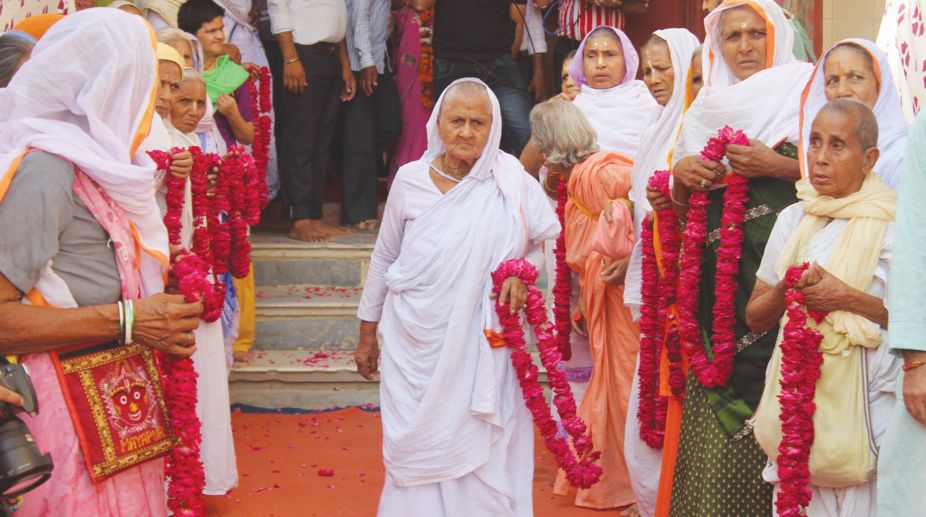Whenever I visited Vrindavan, I would feel bad at the plight of hundreds of old ladies, clad in torn white or saffron saris, begging outside the Banke Bihari Temple. The scene at another sacred city, Varanasi, was also the same. Moved by what I saw, I always gave them some money, prasad and at times even food.
I have always associated Vrindavan with Lord Krishna, who spent his childhood days there. Varanasi is another holy city where a lifetime’s sins are believed to be washed away with just one dip in the holy river Ganges.
But why are these old ladies living and begging in these holy cities? At their age they need the protection of a family and caring of their near and dear ones. I was quite puzzled in my childhood by what I saw until my mother told me everything about them.
These unfortunate ladies are what we call “widows”, who have lost their husbands at some stage of their lives. They are left here by their families ~ even their own sons and daughters ~ to fend for themselves. Some have run away from their family because of the ill-treatment meted out to them.

And the holy cities of Vrindavan and Varanasi are home to thousands of such women passing their time and waiting for death to relieve them of their painful existence ~ thereby attaining Nirvana in the holy towns. But do they really deserve this horrible life at a stage when they have lost their life partners?
I was deeply pained to learn all this. How can I ever think of throwing a human being out of my house, let alone my mother? That’s just unimaginable for me. All this forced me do something and bring their story to the world by doing a photo-feature and writing about them. For this, over the last few months I travelled to Vrindavan and Varanasi a number of times to spend time with these ladies and celebrate festivals.
Tale of two cities
For over 200 years Vrindavan near Mathura and Varanasi have been inundated by a large number of widows from across the country, mainly Bengal, who have been abandoned by their own families. These young and old women are forced to live in extreme misery, facing starvation, passing their days singing bhajans in temples for which they earn a paltry Rs 8 a day, which is not enough for even one meal.
Many resort to begging in the streets or squatting or lying on the steps outside the temples. Often clad in rags, when they breathe their last, there’s nobody even to take care of their cremation. Even young widows, some of them as young as 20-25 years-old, suffer a lonely and dreary life while facing the cruel slings of societal indifference and callousness. Even after death, a proper cremation as per Hindu rites is not available for these ladies. The dead body is often cut into pieces, packed in a bag and disposed of in the river.
External help
Today thanks to the recent efforts of the Supreme Court that asked the National Legal Service Authority (NALSA) to connect with Dr Bindeshwar Pathak of Sulabh International Social Service Organisation and also National Commission for Women (NCW) panel, there is some hope now.
As a result of their efforts, one can now see some upliftment in the lives of the widows of Vrindavan. There is an increased consciousness among people now.

There have been social campaigns in earlier times too. Campaigns by social reformers such as Ishwar Chandra Vidyasagar and Swami Dayanand Saraswati, had compelled the British government to bring the Widow`s Remarriage Act of 1856. Many people felt that widowed life was an unmitigated social evil that must be abolished.
It was none other than Raja Ram Mohan Roy who made the first move towards the betterment of a widow’s life. The sacrifices of his sister-in-law had compelled him to launch a campaign against Sati and for the cause of widow remarriage.
But there are still people in our society, in this day and age, who oppose remarriage of widows, arguing that this was against the established code of belief of religion and society. But through the efforts of a few NGOs and social outfits, we have now started seeing improvement in the lives of these widows.
Celebration time
Diwali and Holi are the two biggest of our festivals, both of which these ladies joyously celebrate. Diwali was a moment of rejoicing and hope for me as well as hundreds of old mothers facing the curse of being a widow.
Their faces were lit up just like the diyas lit everywhere in the courtyard of the age-old Gopinath temple. I also forgot all my miseries when I saw the brightly lit eyes and happy faces of so many old mothers.
In 2017, it was Diwali of a different kind for everyone as we attended a moving event ~ re- marriage of a young widow at the four-centuries-old historical Gopinath temple in Vrindavan. It was a brave young man who came forward to extend a helping hand to a 20- year-old young widow, whose husband had perished in the devastating floods of Kedarnath.

Removing the age-old curse through remarriage of a widow and also by lighting hundreds of diyas was a perfect way of celebrating Diwali. For the widows present at the marriage, this was their real Diwali celebration. “Her marriage is a message for the society that believes a woman’s life ends if she becomes a widow,” said Manu Ghosh, a 90-year-old widow.
Holi, the festival of colours was another festival where one saw active participation of widows and for people like me, it was the happiest occasion of our lives. Playing Holi with over 1,200 kg of Gulal and over 1,200 kg of flower petals brought out the best in them.
They sang, danced and embraced each other happily. The sorrows of their lives vanished at least for the time they were celebrating and this gave me immense pleasure. I felt blessed as I applied gulal on their faces and touched their feet.
Colour white
It’s a real pity that the colour “white”, which encompasses all the colours in the rainbow, on which one can add and splash other colours, changes into a curse as soon as it is a sari. The white sari, the traditional attire of a widow in India, distances her from all other colours. A widow has to forego every occasion of happiness and face hardships because she is considered inauspicious, and is forced to live a horribly austere life.
First the grief of losing one`s husband and then the trauma of living an austere life ~ no vermillion, no bangles, often no hair. A widow has to undergo all this just because she is considered inauspicious. She is even kept away from all ceremonies, festivities and weddings at her own home. Ultimately she is left with no choice but to leave her home and take shelter in some Ashram meant for widows. This is the cruel and ugly face of our patriarchal society.

Why is a woman subjected to such cruel treatment? What are social or religious malpractices responsible for the huge disparity between the fates of a widow and a widower? Why does a widower get easily remarried, while a widow is compelled to remain single and away from happiness and colours of life?
After his wife’s death, nobody objects when a man gets married even in his very old age. He can even marry a teenaged girl and easily make her a widow. All individuals, whether men or women, have a right to marry or remain single.
Then why are widows denied this natural right? All countries, except India, have a legal and social sanction for widows’ remarriage but India is unable to get out of its deep morass of orthodoxy. Here the hopes and aspirations of widows are given a quiet burial.
















